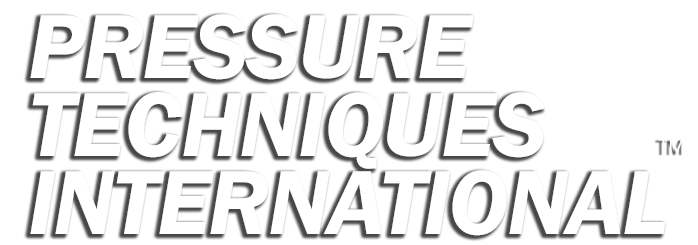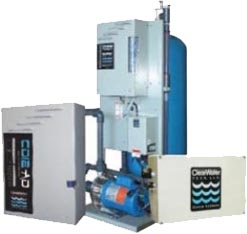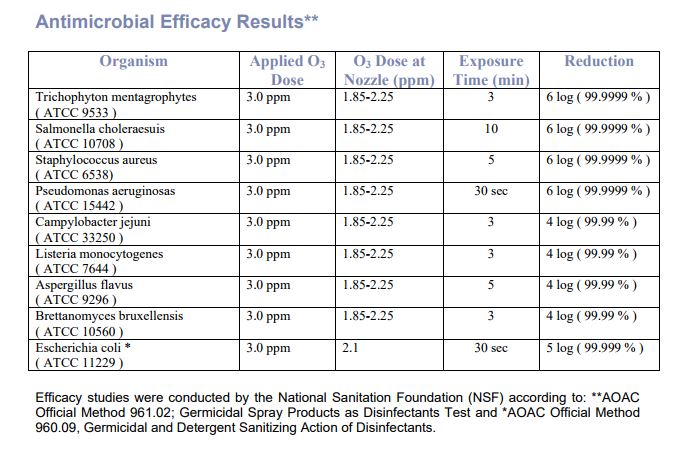What is Ozone & Why Use It?
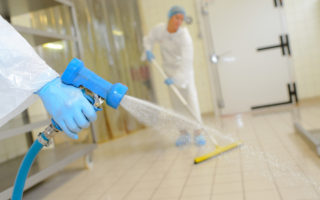 Ozone infused water is the most powerful and fastest acting disinfectant commercially available. It is a safe and environmentally friendly substance in which the only byproducts are oxygen and water.
Ozone infused water is the most powerful and fastest acting disinfectant commercially available. It is a safe and environmentally friendly substance in which the only byproducts are oxygen and water.
In 2001, the FDA recognized the use of ozone in the food industry as Generally Recognized as Safe (GRAS) in gaseous and aqueous phases as an antimicrobial agent on food, including meat and Poultry. It is the only disinfectant capable of a 3-log reduction or greater which is approved to be applied directly on food. Ozone kills bacteria and other pathogens on contact which makes food safer and stay fresher for longer.
Ozone gas is created by exposing oxygen to an electrical charge. Ozone infused water is produced by suspending Ozone gas in water. For more information about ozone infused water generators, click here.
Summary of benefits
- Eliminates 99.99% – 99.9999% of harmful bacteria, viruses, mold, fungi, parasites and pesticides on contact
- Approved for contact with food – does not alter the taste, texture or composition
- Breaks down into oxygen and water after a short period of time
- Safe to handle and poses no risk of tainting food or beverages
- Non-corrosive
Ozone units
Pathogens for Which Ozone is Effective Against
| Pathogen | Also | Also | Also |
|---|---|---|---|
| Aeromanas | |||
| Bacillus cereus | B. cereus | ||
| Campylobacter jejuni | |||
| Clostridium Botulinum | |||
| Clostridium Perfringens | C. Perfringens | ||
| Cryptosporidium | |||
| Cyclospora | |||
| E. coli | |||
| Hepatitis A | |||
| Listeria M. | L. monocytogenes | Listeria spp. | Listeria monocytogenes |
| Norovirus | |||
| Parvovirus | Parvovirus B19 | Fifth disease | |
| Rotavirus | |||
| Salmonella | Salmonella enterica | Salmonella choleraesuis | |
| Shigella | |||
| Staphylococcus aureus | Staphylococcal Enterotoxin | ||
| Vibrio | V. cholerae | V. Vulnificus | V. parahaemolyticus |
| Yersinia enterocolitica | Y. enterocolitical |
Ozone is…
- 10 times more effective than chlorine
- 25 times more effective than Hypochlorous Acid
- 2,500 times more effective than Hypochlorite
- 5,000 times more effective than Chloramine
- Ozone works 3,000 times faster than chlorine
Ozone Considerations & Safety
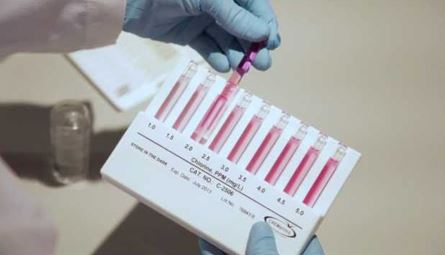 Ozone is a non-residual sanitizer. It does not replace the need to clean.
Ozone is a non-residual sanitizer. It does not replace the need to clean.- The colder the water, the better the ozone gas will bind to water.
- Ozone is corrosive to rubber. If you have rubber gaskets in your equipment that will come into contact with ozonated water, you should swap them out for Viton or EP.
- There is no benefit to having a stronger concentration of ozone than needed. To effectively reduce bacteria in food processing, the concentration of dissolved ozone in water should be around 1 – 2 Parts Per Million depending on the type of application, contact time and other factors. A concentration that is too strong offers no additional benefit and may lead to off-gassing.
- The OSHA limits for exposure to ozone gas in the air is not to exceed .1 ppm in the air over an 8 hour work shift. Ozone gas levels above .3 ppm irritate the respiratory tract and mucous membranes of the eye.
- Test aqueous ozone levels daily at outlets / dispensing points to ensure that the concentration of ozone gas in the water is not too weak or too strong. Keep records for your HACCP plan.
